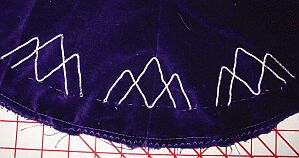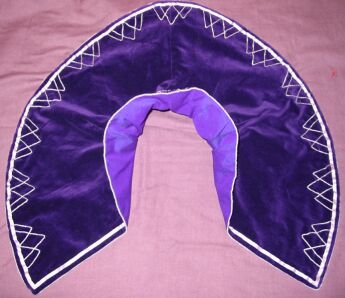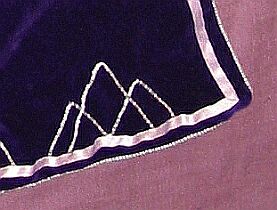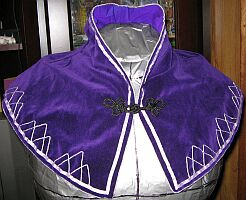
Figure 1: couching of metallic silver thread |
I used silver metallic thread to couch '3 chevronells' - part of my arms - on the edge of the
goller. (German gollar: Though I could find any documentation for the
positioning of the embroidery, Mistress Rowan had commented that
this is a likely place for embroidery on a goller, having found one
"with what looks like chain applied as a decoration just inside the edge - could be gold cord applied in a chain-like pattern." (quoted)
I finished the edge, of my mantellina, with small
faux-pearls I found in my stash. This also gave a bit more weight to
the gollar, helping it to stay in place.
I used a contrasting band at the bottom of the chevronells, so they did not look unfinished.
Examples of contrasting bands have been discussed already.
|
 |
 |
 |
Figure 2: finished gollar, back
|
Figure 3 (middle): Finished gollar, showing front and collar. |
Figrure 4 (far right): close up of pearl edging and decorative
treatment. |
Decoration is the hardest thing when there is no pictorial
evidence. I did add a 'frog' to the front, as this was specifically
mentioned as a form of decoration for mantellino. This was also a
very practicle thing, reducing the slip factor and keeping the dang
thing on! Here is the finished item...
BIBLIOGRAPHY
(Life in Tudor age)
www Kressfoundation dot org
Appelbaum, Stanley. Drawings of Albrecht Durer, Dover, NY 1970, ISBN: 0-486-22352-3
(Fig 40 Portrait of a girl- shows shoulder seams on simple goller.
Kohler, Carl. A History of Costume, Dover, NY 1963 ISBN: 86-21030-8
Holbein, Hans the Younger. Dance of Death, Dover, NY, 1971.
Durer and german renaissance printmaking, Art Gallery of South Australia, Adelaide, 1996.
p55 Melancholia simole with no visible shoulder seam
WEBSITES:
For more pics:
http://www.geocities.com/Athens/Delphi/3212/h-cost3/german3-29-98.html
http://oonagh.actewagl.net.au/german_flirtation.htm german flirtation - Oonagh
Page XII
All intellectual content, photos and layout are copyright to La
Signora Onorata Katerina da Brescia (K Carlisle), except those
original renaissance artworks and extant articles whose copyright
remains with the current owner.
If you would like to use something from
this site, please contact me, and cite this website reference.
c. K.Carlisle. 2006




